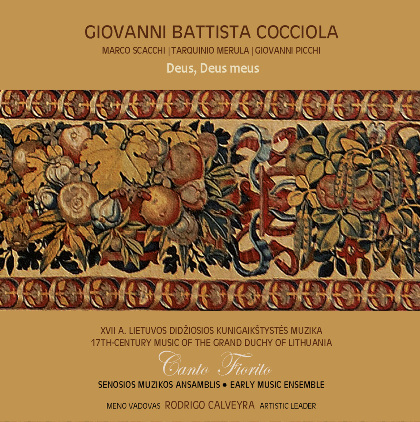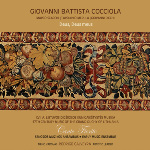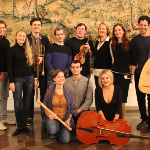
Songs
- artist:Canto Fiorito
- region:Eastern Europe
- release year:2015
- style(s):Early Music
- country:Lithuania
- formats:CD (Compact Disc)
- record posted by:Semplice
- label:semplice
- publisher:semplice
- buy this record
Links
Links between the past and present often disclose unknown layers of artistic life, as well as saving interesting facts of musical life from oblivion. The discovery of 17th-century manuscripts of musical scores has increased our historical store of later Lithuanian music, showing the everyday life and work of musicians who lived here. They have also helped to describe Lithuania’s long road to the family of Christian countries of Western Europe.
At the end of the 16th century, when the Reformation movement had subsided and Catholicism revived, baroque art soon reached the northernmost Catholic country – the Grand Duchy of Lithuania. Many noblemen who wished to redeem their own sins and those of their fathers because of the confessional fallacies, returned to Catholicism and became patrons of Church art. Among other things they supported sacral music in the churches that they maintained.
Many innovations in musical life appeared between 1587–1648, when the country was governed by the rulers of the Commonwealth of the Two Nations – the representatives of the Swedish Vasa dynasty, famous for their exceptional love of Euterpe, the ancient Greek muse of music. The best performers were invited from Italy, among them the famous Italian composers Luca Marenzio, Tarquinio Merula and Marco Scacchi who worked for the royal band. Italian musicians fostered various musical genres and spread essential baroque-style discoveries and innovations: basso continuo, seconda practica, stile moderno, musical rhetoric, theory of affects. functional harmony. All this was crowned by dramma per musica performances. In the palace of the Lower Castle in Vilnius there were three premieres: in 1636 Il ratto di Helena, in 1644 Andromeda and in 1648 Circe delusa. The band that was famous throughout Europe became a source of baroque music and a model to be followed by the noblemen in the Grand Duchy of Lithuania.
One of them was Leo Sapieha (1557–1633), a known statesman and military figure, diplomat, lawmaker, patron of arts, Vilnius voivode, Grand Hetman of the Duchy, who prepared for publication a distinguished juridical document – the Third Statute of Lithuania (1588).
The Vilnius royal band under Sapieha was known all over the country, while the greatest celebrity was its leader, Italian composer and performer Giovanni Battista Cocciola (second half of the 16th–beginning of the 17th century). Since very little is known about the composer’s life either in his native country or abroad, literary mentions of his name allow much scope for different interpretations of his life. It is possible that Cocciola arrived in the Commonwealth of the Two Nations together with some of his countrymen. Soon he was noticed by Sapieha who invited him to lead the palace band, and there he spent a long period of his creative life.
The first mention of Giovanni Battista Cocciola as being a well-known composer of motets, was in a treatise by Michael Praetorius named Syntagma Musicum (1619, Leipzig).
Ernest Ludwig Gerber’s reference book Historisch-Biographisches Lexikon (1790, Leipzig) provides essential facts about the composer thus: “... a famous composer of the past century from Vercelli as the concertmaster of the Lithuanian chancellor Leo Sapieha. In Venice in 1612 a motet and four editions of a Mass for eight voices with basso continuo was published. In Bergman’s collection Parnassus musicus (1615, Venice) there are various motets by this composer.”
Another important source was Concentus harmonici ecclesiastici printed in Antwerp in 1625 of two-, three-, four- and five-voiced compositions with basso continuo. The title page points out: “Joannis Baptistae Cocciolae Vercelensis. Illustrissimi Domini D. Leonis Sapihae Cancellarij Magni Ducatus Lituaniae Musicae Magistri.”
Information about this publication was printed in the Frankfurt book fair catalogues in the autumn of 1625 and spring of 1626 (Karl Albert Göhler, Die Messkataloge im Dienste der Musikalischen Geschichtsforschung, Leipzig, 1901).
In the 18th century when the biographies of more famous composers started to be published, the name of Giovanni Battista Cocciola became known. He was noted as the concertmaster of the royal band of the Lithuanian chancellor Leo Sapieha, and that his motet and eight-voiced Mass with basso continuo were printed in Venice in 1612. The fact that Cocciola was a Sapieha musician, was also noted in other 19th-century publications.
Cocciola’s works have been discovered in the collections of musical notes manuscripts in Lithuania, Poland, and Germany.
*In 1569 when the Lublin Union was concluded, the Kingdom of Poland and the Grand Duchy of Lithuania came to be called the Commonwealth of the Two Nations.



